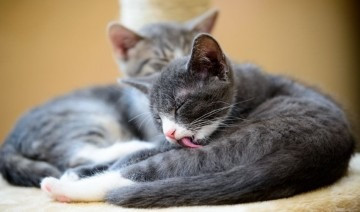Cats are well known for their fastidious grooming habits and their silky, luxurious coats. A variety of skin problems can affect cats, however, and cat owners should be able to recognize these problems in order to take steps to keep their cats healthy can comfortable even with unique or challenging skin conditions.
Causes of Skin Conditions
Cat skin problems can arise from a variety of causes. Some cats may have allergies to flea bites or other pests, or even allergies to pollen, perfumes, or other irritants that can cause skin problems. Poor diet could also lead to unhealthy skin or may exacerbate underlying conditions that affect a cat’s skin and fur. Mental imbalances such as anxiety, fear, and stress can also manifest as a skin condition, and different infections can have symptoms that include skin problems in cats.
Many feline skin conditions present similar symptoms such as redness or rashes, inflamed skin, lumps, baldness, and matted fur. Because these symptoms can be the same for different problems, it is important to consult a veterinarian as soon as any skin problems are noticed so a proper diagnosis can be made and the correct treatment can be used.
Most Common Skin Problems in Cats
There are a wide variety of skin problems that can affect all types of cats, no matter what breed the cat may be or what age they are. The most common and widespread problems include…
- Overgrooming – While cats groom frequently to keep themselves clean, overgrooming can lead to bald patches and inflamed skin, as well as more hair balls for the cat to regurgitate. Allergies or skin infections can lead to overgrooming, or a cat that is nervous or anxious may overgroom in an attempt to soothe itself.
- Allergies – Different allergic reactions can lead to intense itching, rashes, skin bumps, and other problems, often near the base of a cat’s tail. A cat may overgroom because of an allergy, or could nibble away at irritated skin. Fleas and other parasites, pollen, laundry detergents, foods, perfumes, and other allergens could be causing this reaction.
- Miliary Dermatitis – This condition creates small scabs or crusts on a cat’s skin, and is often caused by a dietary deficiency or food allergy. Miliary dermatitis is most often seen around a cat’s head and face, as well as its ears and neck, but could potentially appear on other parts of the body depending on the severity of the reaction.
- Ringworm – This common fungus often affects cats, causing hair loss, scaling, and crusting, typically on a cat’s head, ears, or forelimbs. Reddened skin is typical with this condition and is often seen in a curved or circular pattern. Ringworm can also be passed to humans, so extreme care should be taken with any cat showing ringworm signs.
- Feline Acne – Cats can get pimple-like outbreaks similar to blackheads on their chin and face. This condition could be a reaction to medication, the result of a poor diet, or due to stress, anxiety, or other mental imbalances.
- Ear Mites – These pests love to live in the warm, dark recesses of a cat’s ears, and can create a dark, murky discharge as well as foul odors. A cat with ear mites may scratch at its ears, or may be shaking its head more frequently. Ear mites are most common in kittens and young cats, but can still affect cats of any age.
- Dry Skin – General dry skin can lead to itchiness and dandruff, and may lead to more redness or open wounds as a cat scratches. Diet can cause dry skin, and dehydration, dry climate, or lack of humidity can also cause or exacerbate this condition.
Treating Feline Skin Conditions
Because different conditions can show very similar symptoms, it is critical to have a proper veterinary diagnosis to ensure effective treatment. Depending on the cat’s overall health, age, the exact skin condition, and other health concerns, typical treatments for skin problems in cats include…
- Taking steps to lower the cat’s stress and anxiety. This may include minimizing changes in the daily routine or offering more reassurance to the cat so it can feel at ease and secure.
- Antibiotics and other medication to treat infections. Medications may be oral, topical, or injected, as well as medicated shampoos.
- Improving the cat’s diet to support stronger, healthier skin and fur. This may mean switching food brands or adding supplements to the cat’s diet.
- Allergy shots or other allergy medication to inhibit the cat’s overactive reactions to allergens so there is less skin irritation due to common allergens.
- Flea and pest treatments not just for the cat, but for the household to get rid of pests in bedding, carpeting, upholstery, and other areas where they can bother the cat.
- Improving the cat’s environment by adjusting indoor temperatures and humidity to sooth dry skin or irritation.
If underlying issues are causing a cat’s skin problems, such as a food allergy, stress, or other conditions, those issues must be properly treated to alleviate the skin irritation. Catching and treating skin problems early is the easiest and most effective option, and staying alert to the cat’s grooming habits and overall skin and fur condition can help cat owners be aware of any problems right away. By understanding the different skin problems that can affect cats, what causes those problems, and how to treat them, cat owners can be sure their feline friends remain comfortable and at ease in strong, healthy skin.






Comments